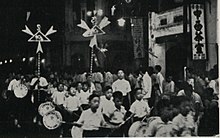Chinese-Malaysian

Chinese school children with lanterns, Penang, 1937.
|
|
| Total population | |
|---|---|
|
6,642,000 23.4% of the Malaysian population (2016) |
|
| Regions with significant populations | |
|
Penang, Kuala Lumpur, Johor, Perak, Selangor, Sarawak Christmas Island |
|
| Languages | |
| Malay, Mandarin, English, Hokkien, Cantonese, Taishanese, Foochow, Hakka, Hainanese, Teochew, and Hinghua; Manglish (creole) | |
| Religion | |
| Predominantly Mahayana Buddhism and Taoism (Chinese folk religion), significant Christianity, minorities Islam and Hinduism | |
| Related ethnic groups | |
| Singaporean Chinese, Peranakan, Overseas Chinese |
| Malaysian Chinese | |||||||||||||||||||||||||||
| Traditional Chinese | |||||||||||||||||||||||||||
|---|---|---|---|---|---|---|---|---|---|---|---|---|---|---|---|---|---|---|---|---|---|---|---|---|---|---|---|
| Simplified Chinese | |||||||||||||||||||||||||||
|
|||||||||||||||||||||||||||
| Alternative Chinese name | |||||||||||||||||||||||||||
| Traditional Chinese | |||||||||||||||||||||||||||
| Simplified Chinese | |||||||||||||||||||||||||||
|
|||||||||||||||||||||||||||
The Malaysian Chinese consist of people of full or partial Chinese—particularly Han Chinese ancestry who were born in or immigrated to Malaysia. The great majority of this group of people are descendants of those who arrived between the early 19th century and the mid-20th century. The Malaysian Chinese population is primarily urban; socioeconomically they are mainly a well-established middle-class ethnic group and traditionally dominate the business and commerce sectors of the Malaysian economy.
Malaysian Chinese form the second largest community of Overseas Chinese in the world, after Thailand. Within Malaysia, they represent the second largest ethnic group in Malaysia after the ethnic Malay majority. They are usually simply referred to as "Chinese" in Malaysia, Orang Cina in Malay, Sina-karan in Tamil and Huaren (Chinese people) or Huaqiao (Overseas Chinese) by Chinese themselves. Most of the Chinese in Malaysia are of Min (e.g. Hokkien), Yue (Cantonese) and Hakka-speaking ancestry, and different towns and cities in Malaysia may be dominated by different Chinese dialects among Chinese speakers, for example Cantonese in Kuala Lumpur, and Hokkien in Penang; Mandarin however is now also widely used. Culturally, most Malaysian Chinese have maintained their Chinese heritage including their various dialects, although the descendants of the earliest Chinese migrants who arrived from the 15th to 17th century have assimilated aspects of the Malay culture and they form a distinct subethnic group known as the Peranakan or Baba-Nyonya.
The Chinese population in Malaysia has been consistently declining percentage-wise since the Malayan independence, from 37.6% in 1957 to 24.6% in 2010. The reason for the decline may be due to a lower birthrate, as well as a high level of emigration in recent decades. According to a report by the World Bank, the Malaysian diaspora around the world in 2010 numbered at around a million with most of them ethnic Chinese, and the main reasons for emigrating are better economic and career prospects abroad as well as a sense of social injustice within Malaysia. The large number of emigrants, many of whom are young and highly educated, resulted in a significant problem of "brain drain" in Malaysia.
...
Wikipedia
